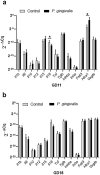Porphyromonas gingivalis-mediated disruption in spiral artery remodeling is associated with altered uterine NK cell populations and dysregulated IL-18 and Htra1
- PMID: 36042379
- PMCID: PMC9427787
- DOI: 10.1038/s41598-022-19239-9
Porphyromonas gingivalis-mediated disruption in spiral artery remodeling is associated with altered uterine NK cell populations and dysregulated IL-18 and Htra1
Abstract
Impaired spiral artery remodeling (IRSA) underpins the great obstetrical syndromes. We previously demonstrated that intrauterine infection with the periodontal pathogen, Porphyromonas gingivalis, induces IRSA in rats. Since our previous studies only examined the end stage of arterial remodeling, the aim of this study was to identify the impact of P. gingivalis infection on the earlier stages of remodeling. Gestation day (GD) 11 specimens, a transition point between trophoblast-independent remodeling and the start of extravillous trophoblast invasion, were compared to late stage GD18 tissues. P. gingivalis was found in decidual stroma of GD11 specimens that already had reduced spiral artery remodeling defined as smaller arterial lumen size, increased retention of vascular smooth muscle, and decreased invasion by extravillous trophoblasts. At GD11, P. gingivalis-induced IRSA coincided with altered uterine natural killer (uNK) cell populations, decreased placental bed expression of interleukin-18 (IL-18) with increased production of temperature requirement A1 (Htra1), a marker of oxidative stress. By GD18, placental bed IL-18 and Htra1 levels, and uNK cell numbers were equivalent in control and infected groups. However, infected GD18 placental bed specimens had decreased TNF + T cells. These results suggest disturbances in placental bed decidual stroma and uNK cells are involved in P. gingivalis-mediated IRSA.
© 2022. The Author(s).
Conflict of interest statement
The authors declare no competing interests.
Figures








Similar articles
-
Porphyromonas gingivalis strain-dependent inhibition of uterine spiral artery remodeling in the pregnant rat.Biol Reprod. 2018 Nov 1;99(5):1045-1056. doi: 10.1093/biolre/ioy119. Biol Reprod. 2018. PMID: 29788108 Free PMC article.
-
Uterine natural killer cells initiate spiral artery remodeling in human pregnancy.FASEB J. 2012 Dec;26(12):4876-85. doi: 10.1096/fj.12-210310. Epub 2012 Aug 23. FASEB J. 2012. PMID: 22919072
-
Altered expression of interleukin-6, interleukin-8 and their receptors in decidua of women with sporadic miscarriage.Hum Reprod. 2013 Aug;28(8):2075-86. doi: 10.1093/humrep/det233. Epub 2013 Jun 5. Hum Reprod. 2013. PMID: 23739222
-
Placental bed research: I. The placental bed: from spiral arteries remodeling to the great obstetrical syndromes.Am J Obstet Gynecol. 2019 Nov;221(5):437-456. doi: 10.1016/j.ajog.2019.05.044. Epub 2019 Jun 1. Am J Obstet Gynecol. 2019. PMID: 31163132 Review.
-
Failure of physiological transformation and spiral artery atherosis: their roles in preeclampsia.Am J Obstet Gynecol. 2022 Feb;226(2S):S895-S906. doi: 10.1016/j.ajog.2020.09.026. Epub 2020 Sep 21. Am J Obstet Gynecol. 2022. PMID: 32971013 Review.
Cited by
-
Maternal gut microbiota in the health of mothers and offspring: from the perspective of immunology.Front Immunol. 2024 Mar 13;15:1362784. doi: 10.3389/fimmu.2024.1362784. eCollection 2024. Front Immunol. 2024. PMID: 38545107 Free PMC article. Review.
-
Differential affinity chromatography reveals a link between Porphyromonas gingivalis-induced changes in vascular smooth muscle cell differentiation and the type 9 secretion system.Front Cell Infect Microbiol. 2022 Nov 22;12:983247. doi: 10.3389/fcimb.2022.983247. eCollection 2022. Front Cell Infect Microbiol. 2022. PMID: 36483452 Free PMC article.
References
-
- Almasry SM, Elmansy RA, Elfayomy AK, Algaidi SA. Ultrastructure alteration of decidual natural killer cells in women with unexplained recurrent miscarriage: A possible association with impaired decidual vascular remodelling. J. Mol. Histol. 2015;46:67–78. doi: 10.1007/s10735-014-9598-8. - DOI - PubMed
Publication types
MeSH terms
Substances
Grants and funding
LinkOut - more resources
Full Text Sources
Molecular Biology Databases
Miscellaneous

